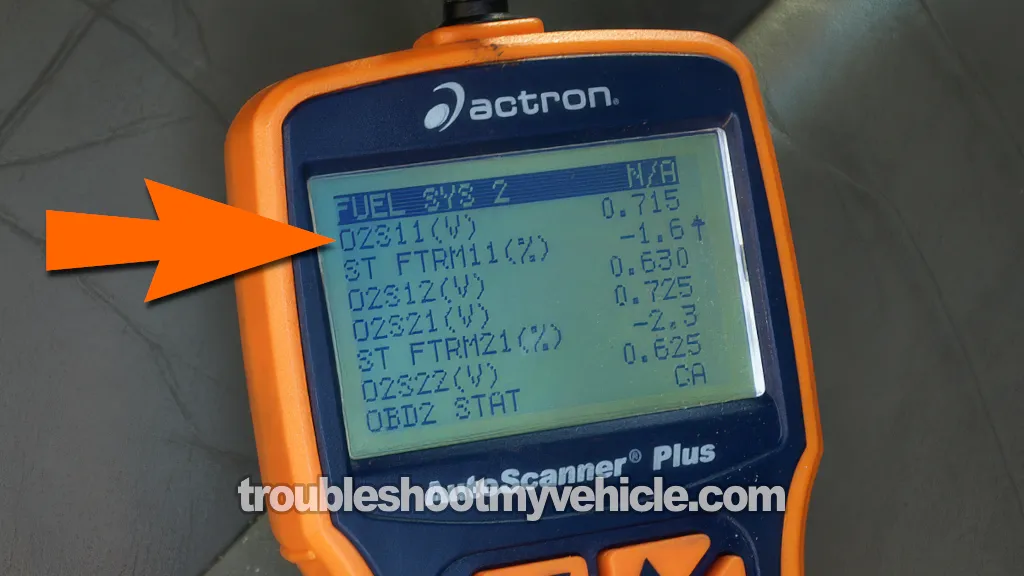TEST 2: Manually Inducing A Lean Condition

Just as we tested how the oxygen sensor reacts to a rich fuel mixture, we can also check its response to a lean condition.
The simplest way to manually create a lean mixture is by allowing unmetered air into the intake system. One of the easiest access points is the large vacuum hose connected to the brake booster's check valve —just slightly loosening it will do the trick.
This hose pulls in a good amount of air when it's loose, and that sudden rush of unmeasured air will cause a lean mixture that your upstream O2 sensor should detect almost immediately.
IMPORTANT: Don't fully remove the hose from the brake booster —doing so can stall the engine.
Instead, just back it out slightly —enough to let some extra air in and lean out the mixture without shutting the engine off. A soft hissing sound usually means it's loose enough.
IMPORTANT: It's a good idea to do a trial run while the engine is off. Try loosening the hose when everything is cold. If it's never been removed, it might be stuck —and that's not something you want to wrestle with while the engine is idling.
These are the test steps:
- 1
Start the engine and let it idle for approximately 15 minutes.
- 2
Plug in your scan tool and switch over to Live Data mode.
- 3
Locate the O2 sensor PID labeled O2S11.
- 4
Begin monitoring the voltage values for the front O2 sensor.
- 5
Carefully loosen the large vacuum hose at the brake booster check valve.
You only need to loosen it enough to allow additional air in. A gentle hissing noise usually confirms you're good to go. - 6
Watch the O2S11 voltage readings.
Both values should drop quickly below 0.200 Volts. In many cases, they may fall as low as 0.050 Volts. - 7
Once you observe the voltage drop and it holds steady, press the vacuum hose firmly back into place.
- 8
Wait a few moments and observe the voltage readings normalize —they should go back to fluctuating between 0.100 and 0.900 Volts just like before.
Now let's break down what your results mean:
CASE 1: The O2S11 voltage showed a drop below 0.200 Volts during the test. That confirms the upstream sensor is functioning correctly and properly detecting a lean mixture.
If you're still seeing O2 sensor codes, the cause may lie elsewhere. Check out the suggestions here: Oxygen Sensor Codes Keep Coming Back.
CASE 2: The O2S11 voltage didn't drop below 0.200 Volts. This means Bank 1 Sensor 1 (O2S11) failed to respond to the lean condition —it should be replaced.
Oxygen Sensor Codes Keep Coming Back
If you've made it this far, chances are you've already run the tests —and maybe even swapped out the upstream O2 sensor. But despite all that, the PCM is still flagging oxygen sensor-related trouble codes.
In other words, the check engine light is back on, and you're seeing the same O2 sensor codes show up again.
When this happens, it's often a sign that the engine is genuinely running either too rich or too lean —but the oxygen sensor itself isn't the real culprit.
To put it another way: something else is throwing off the air/fuel ratio, and the O2 sensor is simply reporting the imbalance —not causing it.
Below are some common issues that can lead to misleading O2 sensor codes:
- Weak fuel pump: If fuel pressure drops too low, the engine may run lean —and the PCM may mistakenly blame the O2 sensor for the problem. This tutorial explains how to check the fuel pump:
- Leaky intake manifold gaskets: Can allow unmeasured air into the intake, creating a lean mixture the PCM struggles to balance.
- Partially clogged or dirty fuel injectors: May result in uneven fuel delivery —some cylinders run too rich, others too lean —which can wreak havoc on the O2 sensor feedback loop.
- Malfunctioning manifold absolute pressure (MAP) sensor: Provides bad intake manifold pressure data, which leads to incorrect fuel calculations.
- Defective engine coolant temperature (ECT) sensor: If it reports that the engine is cold when it's not, the PCM may stay in open loop and overfuel the engine.
- Inaccurate intake air temperature (IAT) sensor: Incorrect readings here can skew how much fuel the PCM thinks is needed, upsetting the air/fuel balance.
- Thermostat stuck open or with the wrong temp rating: Prevents the engine from reaching proper operating temperature, which may keep the PCM in rich mode longer than necessary.
- Exhaust leak before the O2 sensor: Allows fresh air into the exhaust stream, fooling the sensor into thinking the mixture is lean —causing the PCM to add more fuel unnecessarily.
Each of these conditions can mislead the PCM, causing it to adjust the fuel mixture incorrectly —which may appear like an O2 sensor problem, even though the sensor is simply doing what it's supposed to.
The tricky part? These problems can be intermittent. If a sensor or component is just beginning to fail, it might behave normally during testing.
So what's the smartest move? Be patient. Allow time for the issue to become more predictable. Once it starts happening more often, your scan tool is far more likely to catch it in action —and that's when you'll be able to track it down and fix it once and for all.
More 3.9L V6 Dodge Ram Van Test Articles
I've written quite a few 3.9L V6 Dodge Ram van 'how to' tutorials. You can find all here:

If this info saved the day, buy me a beer!

